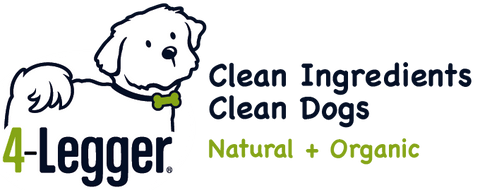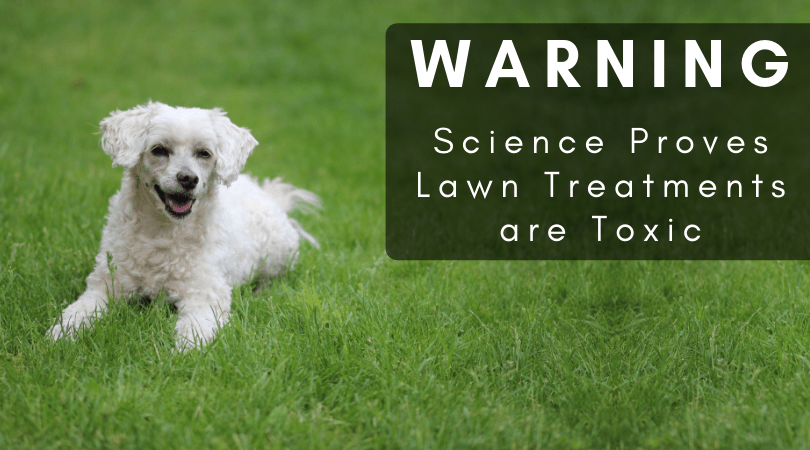Warning: Science Proves Lawn Treatments are Toxic to Dogs
We recently had someone comment on a blog post we wrote last year that our concerns about lawn treatments were all based on emotion and scare tactics, not science.
This is what they said:
"The EPA tests every product used on lawns and determines the safety. Most lawn care products are completely safe when used according to the label, as determined by the EPA, not you!"
I showed the comment to 4-Legger's science guru and then heard hours of ranting. After my eyes had sufficiently glazed over I asked her to write it all down. Here it is.
Peer Reviewed Scientific Studies Shows EPA Isn't Always Right
My first engagement with the EPA was when I was in high school. I did a research project on the levels of lead, zinc, and cadmium in the soil, water, and hair (of animals and humans) around the Galena, Kansas smelter. The smelter, one of the largest in the United States, operated from 1887 until it was closed in the 1970s producing white lead and silver from ore mined in the area.
The EPA said that the levels of lead, zinc and cadmium were below levels set for safety and there was no cause for concern yet the people in Galena felt and said differently.
The residents indicated that they had more learning disabilities (an effect of lead poisoning), cancers, and other health issues in their town than were present in other towns. I talked to people with kidney disease, those who had lost animals to chronic disease, and experienced other health issues linked to heavy metal exposure.
Three years of research led me to believe the residents were right.
While the EPA's test levels showed no cause for concern based on their published studies, my testing - which was mirrored by the samples I sent to the Missouri Department of Natural Resources showed there was significant cause for concern since the samples from the soil, water, and hair all displayed levels of contamination above the EPA safety levels.
While I moved on and went to college, the people left in Galena, Kansas continued to battle the EPA and were later listed as a Superfund site.
Every few years I search PubMed - the catalog of scientific journals so I can see what is happening with Galena.
I remember reading a 1990 study (https://www.ncbi.nlm.nih.gov/pubmed/2363037) that brought tears to my eyes and made me remember conversations with the wonderful people who lived in Galena -
The summary from the 1990 study showed exposures including lead and cadmium in drinking water, mine wastes, and surface soils. They compared illness rates to residents with two other towns in Kansas. Among residents of the three towns who had lived there at least 5 years prior to 1980, there was either a statistically significant prevalence in Galena of chronic kidney disease (females aged greater than or equal to 65), heart disease (females aged greater than or equal to 45), skin cancer (males aged 45-64), and anemia (females aged 45-64). It also revealed statistically significant associations of stroke, chronic kidney disease, hypertension, heart disease, skin cancer, and anemia with variables related to Galena exposure.
There was also a statistically significant excess of deaths from hypertensive disease (females aged greater than or equal to 65), ischemic heart disease (males and females aged greater than or equal to 65), and stroke (females aged greater than or equal to 65). This study confirmed that environmental agents in Galena are associated with, and may have contributed to, the causation of several chronic diseases in residents of this community.
They ended the paper with the same thing I wrote in my research paper back in 1988, "Further studies are recommended."
I think back on the comment from the reader who said the EPA has tested all of the lawn chemicals and they are non-toxic and safe for our pets.
Rubbish.
Recent Glyphosate Studies
A recent study(1) by the International Agency for Research on Cancer (IARC) has classified glyphosate as “probably carcinogenic to humans (Group 2A)" and there is "strong evidence" that exposure to glyphosate is genotoxic through at least two mechanisms known to be associated with human carcinogens (DNA damage and oxidative stress).
Yet, the EPA says that there is no convincing evidence that “glyphosate induces mutations.”
They cited 3 reasons why the EPA and the IARC reached opposing conclusions:
- Much like the Galena KS smelter, the EPA relied upon studies done by the companies that manufactured the products in question.
- The type of glyphosate studied. The EPA studied what is called "technical grade glyphosate" - the primary ingredient - not the final product formulation used.
- The exposure levels and bioaccumulation from use over years verses a one time exposure.
Since the IARC assessment, an additional 26 of 27 published studies have reported evidence that glyphosate can be genotoxic (causes mutations to DNA and may cause cancer).
A Short History of Glyphosate Use
Glyphosate was discovered in 1961.
Glyphosate was approved by the EPA and has been used since the 1970s.
On February 11, 1985 the carcinogenic potential of glyphosate was first considered by an EPA panel, called the Toxicology Branch Ad Hoc Committee. The Committee, in a consensus review dated March 4, 1985, then classified glyphosate as a Class C Carcinogen. A Class C Carcinogen has ”Suggestive evidence of carcinogenic potential” according to the EPA.
In 1991, based upon evidence supplied by the company, the EPA changed the classification to Class E - evidence of non-carcinogenicity for humans. This change occurred the same year Monsanto was developing its first Roundup-Ready (glyphosate resistant genetically modified crops).
In 2012 the French Professor Gilles-Eric Seralini published his famous toxicity study, which showed how rats fed on a diet containing NK603 Roundup tolerant GM maize or given water containing Roundup, at levels permitted in drinking water and GM crops in the U.S., suffered severe liver and kidney damage.
The use of glycophosate has skyrocketed in years. A 2015 study discovered glyphosate in 93% of urine samples collected across the United States.
In 2016, glyphosate was found in "alarming levels" in a wide range of best selling foods across the United States.
In 2017, glyphosate was listed by California’s Office of Environmental Health Hazard Assessment as a chemical known to cause cancer. It was also shown to cause liver disease at low doses by the peer-review study led by Dr. Michael Antoniou at King's College London. This study was ground-breaking as it was the first to show a link between consumption of Roundup in a real-world environmental dose and a serious disease condition.
Also in 2017, internal Monsanto and EPA communications released during court cases have revealed 30+ years of collusion to play down health, safety and toxicity concerns.
In 2018, Montanto lost a landmark cancer trial in San Francisco and was ordered to pay $78 million in damages after it was scientifically proven that non-Hodgkin's lymphoma was caused by glyphosate weed killer.
Towns, states, and countries are now banning glyphosate citing the scientific evidence that it is in fact toxic.
Keep in mind for a minute that these court cases are based on human exposure.
Even the EPA agrees children take in more pesticides relative to body weight than adults and their developing organ systems are more vulnerable and less able to detoxify toxic chemicals (2).
I think it is fair to say this statement can be extended to dogs, cats, birds, and other animals that are exposed to herbicides and pesticides.
We think the scientific evidence linking glyphosate to cancer is the tip of the iceberg. We do not want pet parents to lose their 4-legged family members to cancer like we did before they realize the exposure of these chemicals most definitely cause disease.
While I am certainly emotional when I think about people's lives being so negatively impacted by their exposure to toxic chemicals, I am equally emotional about dogs getting cancer from toxic yard treatments.
To the individual who believes the EPA when they say our content is based on emotion and not science, I say you need to do some reading of the scientific peer review journals. If not for your own sake, for the sake of your dogs and other animals that may pass though your lawn.
References
2 - US EPA, Office of the Administrator, Environmental Health Threats to Children, EPA 175-F-96-001, September 1996.
3 - https://sustainablepulse.com/2017/09/06/a-short-history-of-glyphosate/#.XMRmPZNKjUq





